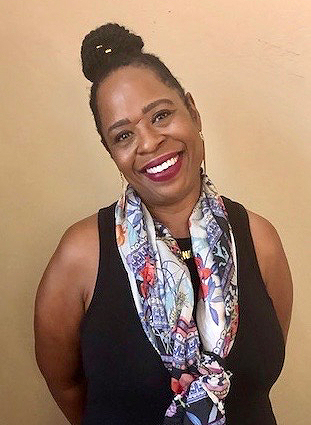CRUNCHING THE NUMBERS WPC

hen W. P. Carey students take an online class, Instructional Designer Senior Ada Malcioln Martin is behind the scenes. Along with five other instructional designers at the school, she assists faculty with creating, building, and maintaining content for online course delivery.
Martin and her fellow instructional designers play a crucial role in making sure the tools students use to learn are practical and easy to understand. They look for gaps in knowledge and come up with ways to fill them, whether through games, tutorials, or articles. They also collaborate with faculty to develop curriculum and test learning to make sure students are ready for the next challenge. Because instructional designers are experts in technology and education, they must stay up to date on changes in both fields.
Martin began her career in higher education during the mid- to late 1990s, when online education in the United States was in its infancy and online enrollment was a fraction of what it is today. Online courses have quadrupled in the past 15 years and are growing even more quickly around the world. Among current college students (undergrad) who were enrolled at four-year institutions before March 1 and COVID-19, 97% have switched to online instruction.
Today’s learners have grown and changed, too. They’re not only college co-eds solely focused on school but also working professionals who are juggling school and career. For these new students, online learning must be accessible, convenient, and applicable to their daily lives.
- Today’s average online student is 25 or older.
- 42% are students of color.
- 64% work.
- 40% work full time.
Two studies, the 2017 and 2019 Online College Students reports, seek to help higher education leaders and policymakers both better understand the traits of online college students and what they’re looking for in their educational experience.
The 2019 report found that current students are interested in programs that provide a sense of community. They’re also technologically savvy, want to be able to access their content across multiple devices, and seek competency-based education. Of the 1,500 prospective, current, and recently graduated fully online college students, the report found:
- More than half say interaction with classmates and instructors is important to them.
- About one-quarter say contact with their instructors and more engagement with class-mates would improve their online courses.
- 59% travel to campus between one and five times per year, for reasons such as meeting their instructor or study group.
- 56% of online students use smartphones or tablets for course activities.
- 63% of graduate students use mobile devices for courses.
- 52% of undergraduates are likely to use mobile devices in conjunction with their class activities.
- 18% of students say they have enrolled in a CBE program.
- 31% are very familiar with the concept.


- Blended learning classrooms where students can complete the bulk of their work (e.g., assignments, exams, etc.) online, then spend classroom time engaging with instructors and having in-depth conversations.
- Online programs with synchronous components, including videoconferencing tools such as Zoom.
- Tools such as VoiceThread for some assignments, allowing students to create multimedia presentations using images, videos, and slides.
- Class environments capable of displaying course content accessible to students across multiple devices.
- Competency-based courses through its Continuing and Professional Education program. Students can choose from several business classes, register, learn at their pace, and get awarded résumé-ready badges and certificates online.
The 2017 report found that:
- Today’s students want the ability to witness and measure their progress as they complete course materials. “Students know the tasks they must complete each week, thanks to [course management system] Canvas,” explains Martin. “Canvas generates a to-do list for them to check off completed items as they go through their courses. Students can also check their progress regularly in the grades area as they move through each week. Instructors can conduct analytics on students to measure their progress in the course through Canvas, too.”
- Students returning to school for increased career advancement opportunities need to see that what they’re learning can be applied to current and future positions. That’s why many W. P. Carey professors use case study assignments, allowing students to apply what they’re learning to real-life scenarios.
- Returning students who already have degrees may not be interested in obtaining additional degrees; some merely want to expand their existing knowledge, while others want to see immediate results for their efforts. As they gain expertise in a specific area, they want to earn stackable credentials they can use while working toward a final degree. W. P. Carey’s new Professional Credential in Tech Consulting is one of the first stackable credentials offered by a top-ranked business school. It can be applied toward a future Master of Science in Information Systems Management degree, accounting for nine of the 30 required credit hours.

EducationData.org in partnership with National Center for Education Statistics (NCES) and the World Bank, 2017 Online Education Statistics. Retrieved from educationdata.org/online-education-statistics
Babson Survey Research Group in partnership with the Online Learning Consortium (OLC), 2015 Online Report Card – Tracking Online Education in the United States. Retrieved from onlinelearningconsortium.org/read/online-report-card-tracking-online-education-united-states-2015
Clinefelter, D. L., & Aslanian, C. B. (2017). Online college students 2017: Comprehensive data on demands and preferences. Louisville, KY: The Learning House, Inc.
Clinefelter, D. L., Aslanian, C. B., & Magda, A. J. (2019). Online college students 2019: Comprehensive data on demands and preferences. Louisville, KY: Wiley edu, LLC
Educase (n.d). Competency-Based Education. Retrieved from library.educause.edu/topics/teaching-and-learning/competency-based-education-cbe
Lumina Foundation (n.d.). Today’s Student. Retrieved from luminafoundation.org/todays-student